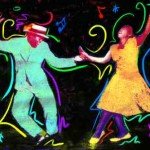Music that moves you
Hello dear reader
 We have been enjoying some rare sun this weekend in the UK and I have been spending time in London’s parks, as part of my campaign to enjoy the best of the city before I leave in September. I attended a super Birthday party for a good friend’s son in the flower garden of Greenwich park where there was plentiful food, games and laughter. And today I have wandering around some of the fine markets in the south of the city, surrounded by fantastic reggae music.
We have been enjoying some rare sun this weekend in the UK and I have been spending time in London’s parks, as part of my campaign to enjoy the best of the city before I leave in September. I attended a super Birthday party for a good friend’s son in the flower garden of Greenwich park where there was plentiful food, games and laughter. And today I have wandering around some of the fine markets in the south of the city, surrounded by fantastic reggae music.
As I was making my way through the market stalls I found myself bobbing my head and tapping my hands to the infectious Caribbean rhythms. Isn’t it funny how music can sometimes trigger you to move before you even realise?
One of the most powerful elements of music that can stimulate us to move is ‘groove’. My new colleagues at the Lucerne School of Music study the phenomenon – why does ‘groove’ make us move – so I am looking forward to learning more about the effect in the near future.
For now I am reading up on a fascinating new article on groove by Jan Stupacher and colleagues from several of the top German music psychology labs (full reference at the end of this blog). These clever researchers have shown that our brain’s motor system is triggered by the presence of groove in music and that subsequent cortical excitability is higher in musicians.
FIrst question, what is groove? The most common definition I can find is ‘that aspect of music that makes us want to move’ – that does not tell us much about the actual nature of the music does it?! In my book I have said:
 “The beat, the thing we tap along to in a great track – the pulse of music – is not something that necessarily needs to be physically present (audible). Musicians do not need to emphasise the pulse of music constantly or even include a note on every ‘beat’ within music. Non-audible beat is referred to as ‘implied’; it is something we perceive out of the sound, like the way we extract a sense of depth in a flat canvas or photograph.
“The beat, the thing we tap along to in a great track – the pulse of music – is not something that necessarily needs to be physically present (audible). Musicians do not need to emphasise the pulse of music constantly or even include a note on every ‘beat’ within music. Non-audible beat is referred to as ‘implied’; it is something we perceive out of the sound, like the way we extract a sense of depth in a flat canvas or photograph.
A great example of the use of implied beat exists in ‘groove’ –based music where the beat emerges from a complex, multilayered and often syncopated pattern of rhythms and instrumentation. Groove music is present across a range of genres including funk, soul, hiphop, drum’n bass, reggae, jazz and world music”.
Groove is primarily shaped by percussion instruments, or those that produce lower frequencies, and involves setting up a predictable patterns of beats as well as subtle micro-variations to maintain a level of interest in the listener. Most groove music has a peak tempo of around 120bpm; a time scale that matches our preferred body movements such as tapping or dance.
We have known for some time that listening to music is associated with activity in the brain’s motor system, even when the listener is completely still. But no-one until now has looked at whether the motor response activity of the brain can be used as a marker for the presence of more or less groove.

In the present paper the researchers used two brain stimulation techniques. Firstly,TMS (transcranial magnetic stimulation) was employed over the primary motor cortex to trigger muscle activity in the arm; then EMG (electromyography) was applied to measure the extent of the resulting response. The researchers timed their TMS pulses to on- or off- beat in music to see whether the presence of the beat influenced motor excitability.
The researchers measured responses in matched high (Superstition), low (Cheeseburger in Paradise) and no groove music (spectral noise)
The researchers tested musicians and non-musicians, and both groups rated the groove in a very similar way; higher ratings for the high compared to low groove music.
What about the motor evoked potentials (MEPs), those measurements of brain response? The MEPs were significantly modulated by the high groove music and but not the low groove and no groove music (these last two were not different overall). This result suggests that high groove really does engage our brain’s motor system.
The musicians were particularly responsive to the TMS pulses that were ‘on-beat’ suggesting that their auditory motor system is more highly tuned to strong groove beats as compared to people who have had little musical training.
I would love to know in the future how this result is modulated by differing amounts of musical listening, musical activity (such as dancing) or liking for groove-based genres. Can you, and if so how exactly how would you, train the brain to respond to ‘groove’?
Interestingly the non-musicians in this study showed a high amount of EMG activity in advance of the TMS pulses – the researchers put this down to them actively trying to suppress movements, as they were instructed, in the presence of high groove. Sometimes it can be a struggle to get the brain not to move to a groove!
This new study marks another great piece of evidence that groove in music really can excite the motor areas of our brain, the neural signature of that irresistible urge to bob your head and tap your foot; moreover, we see here for the first time that degree of groove we feel can modulate that brain response, especially in musicians. Now, go play Superstition at a decent volume (safe, of course) and I dare you to resist the groove!
Reference
Stupacher, J. et al. (2013) Musical groove modulates motor cortex excitability: A TMS investigation. Brain and Cognition, 82, 127-136.

2 Comments
Hannah Whiteside
I am so glad I came across this article! I used to work for Petr Janata at the Center for Mind and Brain in Davis, Ca and was focused on his “Groove” project. I think groove is a great aspect of music to study because it can give further insight into the connection between the cognitive and behavioral aspects of music. One of the most interesting things I found when working under this project was the responses subjects gave when asked to define “groove.” What amazed me was just how similar everyone’s idea of groove was. Almost every subject identified it as a quality almost separate from the music itself that caused the listener to move. By maneuvering through every day life I have found that feeling in the groove applies not only to music, but to many activities and experiences. One can feel in the groove when writing a story, or a soccer team (sorry, football team) can get into a groove during certain parts of the game. It seems to always incorporate a synergy or coordination between the mind and the brain. Thank you for posting this I really hope this is just the beginning for research in the groove.
vicky
Hi Hannah
Thanks so much for these insightful and interesting comments; it sounds like you worked on a really interesting “groove” project! I think you have a very valid point about the role of groove-type feeling in the wider world.
All the best,
Vicky